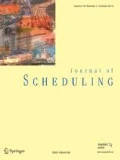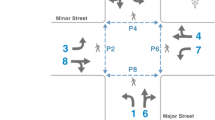Abstract
In addition to having to handle constantly increasing numbers of aircraft, modern airports also have to address a wide range of environmental regulations and requirements. As airports work closer and closer to their maximal possible capacity, the operations problems that need to be solved become more and more complex. This increasing level of complexity leads to a situation where the introduction of advanced decision support systems becomes more and more attractive. Such systems have the potential to improve efficient airside operations and to mitigate against the environmental impact of those operations. This paper addresses the problem of moving aircraft from one location within an airport to another as efficiently as possible in terms of time and fuel spent. The problem is often called the ground movement problem and the movements are usually from gate/stands to a runway or vice-versa. We introduce a new sequential graph based algorithm to address this problem. This approach has several advantages over previous approaches. It increases the realism of the modelling and it draws upon a recent methodology to more accurately estimate taxi times. The algorithm aims to absorb as much waiting time for delay as possible at the stand (with engines off) rather than out on the taxiways (with engines running). The impact of successfully achieving this aim is to reduce the environmental pollution. This approach has been tested using data from a European hub airport and it has demonstrated very promising results. We compare the performance of the algorithm against a lower bound on the taxi time and the limits to the amount of waiting time that can be absorbed at stand.




Similar content being viewed by others
References
ACI EUROPE. (2010). An outlook for Europe’s airports—Facing the challenges of the 21st century. Technical Report, Airports Council International Europe. http://www.aci-europe.org.
Atkin, J. A. D., Burke, E. K., & Greenwood, J. S. (2010a). TSAT allocation at London Heathrow: The relationship between slot compliance, throughput and equity. Public Transport, 2(3), 173–198. doi:10.1007/s12469-010-0029-2.
Atkin, J. A. D., Burke, E. K., & Greenwood, J. S. (2011a). A comparison of two methods for reducing take-off delay at London Heathrow Airport. Journal of Scheduling, 14(5), 409–421. doi:10.1007/s10951-011-0228-y.
Atkin, J. A. D., Burke, E. K., & Ravizza, S. (2010b). The airport ground movement problem: Past and current research and future directions. In Proceedings of the 4th international conference on research in air transportation (ICRAT 2010), Budapest, Hungary, pp. 131–138.
Atkin, J. A. D., Burke, E. K., & Ravizza, S. (2011b). A more realistic approach for airport ground movement optimisation with stand holding. In Proceedings of the 5th multidisciplinary international scheduling conference (MISTA) (2011), Arizona, Phoenix, USA.
Atkin, J. A. D., Burke, E. K., Greenwood, J. S., & Reeson, D. (2007). Hybrid metaheuristics to aid runway scheduling at London Heathrow Airport. Transportation Science, 41(1), 90–106. doi:10.1287/trsc.1060.0163.
Balakrishnan, H., & Jung, Y. (2007). A framework for coordinated surface operations planning at Dallas-Fort Worth International Airport. In Proceedings of the AIAA guidance, navigation, and control conference, Hilton Head, SC, USA.
Brinton, C., Provan, C., Lent, S., Prevost, T. & Passmore, S. (2011). Collaborative departure queue management: An example of airport collaborative decision making in the United States. In Proceedings of the 9th USA/Europe air traffic management research and development seminar, Berlin, Germany.
Burgain, P., Feron, E., & Clarke, J. P. (2009). Collaborative virtual queue: Benefit analysis of a collaborative decision making concept applied to congested airport departure operations. Air Traffic Control Quarterly, 17(2), 195–222.
Chen J., Ravizza, S., Atkin, J. A. D., & Stewart, P. (2011). On the utilisation of fuzzy rule-based systems for taxi time estimations at airports. In Proceedings of the 11th workshop on algorithmic approaches for transportation modelling, optimization, and systems (ATMOS, 2011), Saarbrücken, Germany, pp. 134–145. doi:10.4230/OASIcs.ATMOS.2011.134.
Cormen, T. H., Leiserson, C. E., Rivest, R. L., & Stein, C. (2001). Introduction to algorithms (2nd ed.). Cambridge/London: MIT Press/McGraw-Hill.
Dijkstra, E. W. (1959). A note on two problems in connexion with graphs. Numerische Mathematik, 1, 269–271. doi:10.1007/BF01386390.
Dorndorf, U., Drexl, A., Nikulin, Y., & Pesch, E. (2007). Flight gate scheduling: State-of-the-art and recent developments. Omega, 35(3), 326–334. doi:10.1016/j.omega.2005.07.001.
Gawrilow, E., Köhler, E., Möhring, R., & Stenzel, B. (2008). Dynamic routing of automated guided vehicles in real-time. In Mathematics—Key technology for the future (pp. 165–178). London: Springer.
Idris, H. R., Clarke, J. P., Bhuva, R., & Kang, L. (2002). Queuing model for taxi-out time estimation. Air Traffic Control Quarterly, 10(1), 1–22.
Kim, B., & Rachami, J. (2008). Aircraft emissions modeling under low power conditions. In Proceedings of the A &WMA’s 101st annual conference and exhibition, Portland, OR, USA.
Lesire, C. (2010). Iterative planning of airport ground movements. In Proceedings of the 4th international conference on research in air transportation (ICRAT 2010), Budapest, Hungary, pp. 147–154.
Marín, Á. (2006). Airport management: Taxi planning. Annals of Operations Research, 143(1), 191–202. doi:10.1007/s10479-006-7381-2.
Marín, Á., & Codina, E. (2008). Network design: Taxi planning. Annals of Operations Research, 157(1), 135–151. doi:10.1007/s10479-007-0194-0.
Morris, K. M. (2005). Results from a number of surveys of power settings used during taxi operations. Technical Report, ENV/KMM/1126/14.8, British Airways. www.britishairways.com/cms/global/pdfs/csr/PSDHTechnicalReports.pdf.
Petroccione, L. (2007). Delta’s operation clockwork, transforming the fundamentals of an airline. Principal Transportation & Logistics Practice: Decision Strategies, Inc.
Rappaport, D. B., Yu, P., Griffin, K., & Daviau, C. (2009). Quantitative analysis of uncertainty in airport surface operations. In Proceedings of the AIAA aviation technology, integration, and operations conference.
Ravizza, S. (2009). Control of automated guided vehicles (AGVs). Master’s thesis, ETH Zurich, Switzerland.
Ravizza, S., & Atkin, J. A. D. (2011). Exploration of the ordering for a sequential airport ground movement algorithm. Technical Report, 1543, University of Nottingham. http://eprints.nottingham.ac.uk/1543/.
Ravizza, S., Atkin, J. A. D., Maathuis, M. H., & Burke, E. K. (2012). A statistical approach for improving taxi time estimations at airports. Journal of the Operational Research Society. Advance online publication. doi:10.1057/jors.2012.123.
Roling, P. C., & Visser, H. G. (2008). Optimal airport surface traffic planning using mixed-integer linear programming. International Journal of Aerospace Engineering, 2008(1), 1–11. doi:10.1155/2008/732828.
Rosenberger, J. M., Schaefer, A. J., Goldsman, D., Johnson, E. L., Kleywegt, A. J., & Nemhauser, G. L. (2002). A stochastic model of airline operations. Transportation Science, 36(4), 357–377. doi:10.1287/trsc.36.4.357.551.
Rosenberger, J. M., Schaefer, A. J., Goldsman, D., Johnson, E. L., Kleywegt, A. J., Nemhauser, & George, L. (2000). Air transportation simulation: SimAir: A stochastic model of airline operations. In Proceedings of the 32nd conference on Winter simulation, San Diego, CA, USA.
Sedgewick, R., & Vitter, J. S. (1986). Shortest paths in Euclidean graphs. Algorithmica, 1(1), 31–48. doi:10.1007/BF01840435.
Stenzel, B. (2008). Online disjoint vehicle routing with application to AGV routing. Ph.D. thesis, TU Berlin, Germany.
Acknowledgments
The authors wish to thank the Engineering and Physical Sciences Research Council (EPSRC) for providing the funding which made this research possible. We would also like to thank Flughafen Zürich AG who provided the real dataset and especially Giovanni Russo for his continuous support and Daniele Gullo for valuable feedback and suggestions. Moreover, the authors thank the anonymous reviewers who have helped to improve this paper.
Author information
Authors and Affiliations
Corresponding author
Rights and permissions
About this article
Cite this article
Ravizza, S., Atkin, J.A.D. & Burke, E.K. A more realistic approach for airport ground movement optimisation with stand holding. J Sched 17, 507–520 (2014). https://doi.org/10.1007/s10951-013-0323-3
Received:
Accepted:
Published:
Issue Date:
DOI: https://doi.org/10.1007/s10951-013-0323-3




